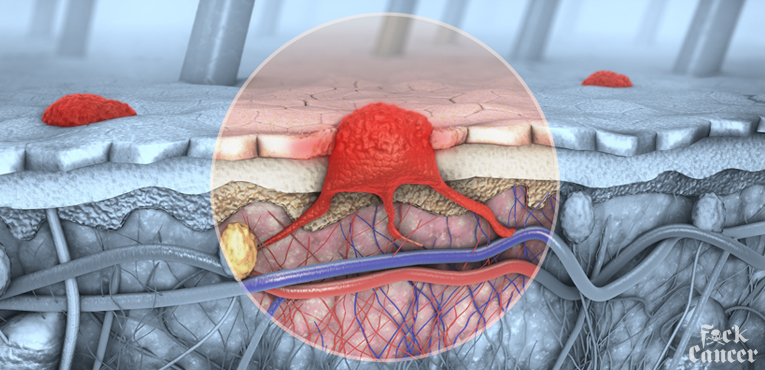
What Is Melanoma Skin Cancer?
Melanoma is a type of skin cancer that develops when melanocytes (the cells that give the skin its tan or brown color) start to grow out of control.
Cancer starts when cells in the body begin to grow out of control. Cells in nearly any part of the body can become cancer, and can then spread to other areas of the body.
Melanoma is much less common than some other types of skin cancers… but melanoma is more dangerous because it’s much more likely to spread to other parts of the body if not caught and treated early.

Where do skin cancers start?
Most skin cancers start in the top layer of skin, called the epidermis. There are 3 main types of cells in this layer:
- Squamous cells: These are flat cells in the upper (outer) part of the epidermis, which are constantly shed as new ones form.
- Basal cells: These cells are in the lower part of the epidermis, called the basal cell layer. These cells constantly divide to form new cells to replace the squamous cells that wear off the skin’s surface. As these cells move up in the epidermis, they get flatter, eventually becoming squamous cells.
- Melanocytes: These are the cells that can become melanoma. They normally make a brown pigment called melanin, which gives the skin its tan or brown color. Melanin protects the deeper layers of the skin from some of the harmful effects of the sun.
The epidermis is separated from the deeper layers of skin by the basement membrane. When a skin cancer becomes more advanced, it generally grows through this barrier and into the deeper layers.
Melanoma skin cancers
Melanoma is a cancer that begins in the melanocytes. Other names for this cancer include malignant melanoma and cutaneous melanoma. Most melanoma cells still make melanin, so melanoma tumors are usually brown or black. But some melanomas do not make melanin and can appear pink, tan, or even white.
Melanomas can develop anywhere on the skin, but they are more likely to start on the trunk (chest and back) in men and on the legs in women. The neck and face are other common sites.
Having darkly pigmented skin lowers your risk of melanoma at these more common sites, but anyone can get melanoma on the palms of the hands, soles of the feet, or under the nails. Melanomas in these areas make up a much larger portion of melanomas in African Americans than in whites.
Melanomas can also form in other parts of your body, such as the eyes, mouth, genitals, and anal area, but these are much less common than melanoma of the skin.
Melanoma is much less common than some other types of skin cancer. But melanoma is more dangerous because it’s much more likely to spread to other parts of the body if not caught and treated early.
Other types of skin cancer
There are many other types of skin cancer. Skin cancers that are not melanomas are sometimes grouped as non-melanoma skin cancers because they develop from skin cells other than melanocytes. They tend to behave very differently from melanomas and are often treated with different methods.
Basal cell and squamous cell skin cancers
Basal cell and squamous cell cancers are by far the most common skin cancers, and actually are more common than any other form of cancer. Because they rarely spread (metastasize) to other parts of the body, basal cell and squamous cell skin cancers are usually less concerning and are treated differently from melanoma.
Less common skin cancers
Other types of non-melanoma skin cancer are much less common than basal and squamous cell cancers and are treated differently. They include:
- Merkel cell carcinoma
- Kaposi sarcoma
- Cutaneous (skin) lymphoma
- Skin adnexal tumors (tumors that start in hair follicles or skin glands)
- Various types of sarcomas
Together, these types account for less than 1% of all skin cancers.
Benign skin tumors
Many types of benign (non-cancerous) tumors can develop from different types of skin cells.
Benign tumors that start in melanocytes
A mole (nevus) is a benign skin tumor that develops from melanocytes. Almost everyone has some moles. Nearly all moles (nevi) are harmless, but having some types can raise your risk of melanoma.
A Spitz nevus is a kind of mole that sometimes looks like melanoma. It’s more common in children and teens, but it can also be seen in adults. These tumors are typically benign and don’t spread. But sometimes doctors have trouble telling Spitz nevi from true melanomas, even when looking at them under a microscope. Therefore, they are often removed, just to be safe.
Benign tumors that develop from other types of skin cells
- Seborrheic keratoses: tan, brown, or black raised spots with a “waxy” texture
- Hemangiomas: benign blood vessel growths, often called strawberry spots
- Lipomas: soft growths made up of fat cells
- Warts: rough-surfaced growths caused by some types of human papilloma virus (HPV)
Most of these tumors rarely, if ever, turn into cancers. There are many other kinds of benign skin tumors, but most are not very common.
.
.
.
.
.
Source: American Cancer Society, What Is Melanoma, https://www.cancer.org/cancer/melanoma-skin-cancer/about/what-is-melanoma.html, August 14, 2019
fuck cancer, fxck cancer, f cancer, fuck cancer foundation, fxck cancer foundation, f cancer foundation, cancer awareness, cancer detection, cancer prevention, cancer education
